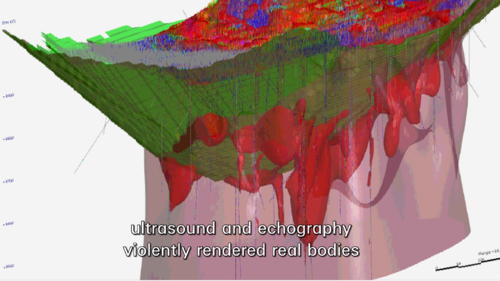Difference between revisions of "Volumetric Regimes"
m |
|||
| (96 intermediate revisions by 7 users not shown) | |||
| Line 1: | Line 1: | ||
__NOTOC__ | __NOTOC__ | ||
| − | This wiki | + | <div class="hi">This wiki was a workspace for the making of the book ''Volumetric Regimes'', edited by [https://possiblebodies.constantvzw.org/inventory/ Possible Bodies] (Jara Rocha and Femke Snelting). It is published by Open Humanities Press (2022) in the [http://www.data-browser.net/ DATA browser series], edited by Geoff Cox and Joasia Krysa. Design and lay-out implemented by [https://manettaberends.nl Manetta Berends] based on a [http://www.data-browser.net/design.html template developed by Stuart Bailey].</div> |
| − | [[File: | + | [[File:VRcover.png|frameless|100px|left]]''Bodies are concrete reality. Bodies are abstract. When bodies are modelled, scanned, generated in virtual realities, and presented back to us and others, are they real, ideal, neutral, skewed? When abstracted bodies speak for us and do things on our behalf, what politics do they enact? This radical multi-form collective investigation traces the cutting edge of how bodies and subjects are rendered technologically. It proposes multi-dimensional forms of intervention, and claims an experimental horizon of the possible, shattering the mantra of unavoidability.'' — Olga Goriunova |
| − | + | ''Volumetric Regimes makes an essential contribution to the ways in which we must rethink matter politically and ecologically. As the book unfolds, ontological questions of intensities, dimensions, and substance are denaturalised as mere properties of matter that can be measured, modified, and thus computed, which today are exemplified by 3D modelling and parametric design, but are shown to be part of processional life-worlds that are relational and mutually informed and informing. Not the partitioning of bodies, particles, datapoints, and spaces as techno-capital and techno-science would have it but a material enmeshment that brings the volumetric into presence otherwise.'' — Susan Schuppli | |
| − | |||
| − | Volumetric Regimes | + | == Volumetric Regimes: Material cultures of quantified presence == |
| − | + | [[File:Book.png|border|500px]] | |
| − | + | '''3D computation has historically co-evolved with Modern technosciences, and aligned with the regimes of optimisation, normalisation and hegemonic world order. The legacies and projections of industrial development leave traces of that imaginary and tell the stories of a lively tension between "the probable" and "the possible". Defined as the techniques for measuring volumes, volumetrics all too easily (re)produce and accentuate the probable, and this process is intensified within the technocratic realm of contemporary hyper-computation. The ubiquity of efficient operations is deeply damaging in the way it gradually depletes the world of all possibility for engagement, interporousness and lively potential. ''Volumetric Regimes: Material cultures of quantified presence'' proposes an urgent intersectional inquiry into volumetrics to foreground procedural, theoretical and infrastructural practices that provide with a widening of the possible.''' | |
| − | + | ''Volumetric Regimes'' emerges from [https://possiblebodies.constantvzw.org Possible Bodies], a collaborative project on the intersection between artistic and academic research. The project was initiated in 2016 to explore the very concrete and at the same time complex and fictional entities of so-called "bodies" in the context of 3D computation. ''Volumetric Regimes'' brings together diverse materials from an ongoing conversation between artists, software developers and theorists working with techniques and technologies for detecting, tracking, printing, modelling and rendering volumes. | |
| − | + | Contributors: Sophie Boiron, Maria Dada, Pierre Huyghebaert, Phil Langley, Nicolas Malevé, Romi Ron Morrison, Simone C. Niquille, Helen V. Pritchard, Jara Rocha, Sina Seifee, Femke Snelting, Kym Ward. | |
| − | + | → [[Introduction|More about '''Volumetric Regimes''']] | |
| − | == | + | == Textos en español == |
| − | + | * "Regímenes volumétricos: Culturas materiales de la presencia cuantificada" (forthcoming, Fem Tek publication, 2023) | |
| + | * "El inventario de Possible Bodies: la des-orientación y sus consecuencias" (translated and published by nmenos1, 2021) | ||
| + | * "La imaginación invasiva y sus cortes agenciales". (Utopía. Revista de Crítica Cultural, Abril-Junio 2019) | ||
| + | == Contents == | ||
| + | * '''[[Acknowledgements]]''' | ||
| + | * '''[[Foreword]]'''<br>Blanca Pujals | ||
| + | * '''[[Introduction|Volumetric Regimes: Material cultures of quantified presence]]''' | ||
| + | === [[x,_y,_z|x, y, z: Dimensional Axes of Power]] === | ||
| + | {{:x,_y,_z}} | ||
=== [[parametric_unknowns|Parametric Unknowns: Hypercomputation between the probable and the possible]] === | === [[parametric_unknowns|Parametric Unknowns: Hypercomputation between the probable and the possible]] === | ||
| − | + | {{:parametric_unknowns}} | |
| + | === [[Somatopologies|Somatopologies: On the ongoing rendering of corpo-realities]] === | ||
| + | {{:Somatopologies}} | ||
| + | === [[clandestine_disorder|Signs of Clandestine Disorder: The continuous aftermath of 3D-computationalism]] === | ||
| + | {{:clandestine_disorder}} | ||
=== [[depths_and_densities|Depths and Densities: Accidented and dissonant spacetimes]] === | === [[depths_and_densities|Depths and Densities: Accidented and dissonant spacetimes]] === | ||
| − | + | {{:depths_and_densities}} | |
| − | === [[Colophon]] | + | === Appendix === |
| + | {{ :Appendix }} | ||
| + | * '''[[Series_Colophon|Colophon]]''' | ||
Latest revision as of 12:02, 14 September 2022
Bodies are concrete reality. Bodies are abstract. When bodies are modelled, scanned, generated in virtual realities, and presented back to us and others, are they real, ideal, neutral, skewed? When abstracted bodies speak for us and do things on our behalf, what politics do they enact? This radical multi-form collective investigation traces the cutting edge of how bodies and subjects are rendered technologically. It proposes multi-dimensional forms of intervention, and claims an experimental horizon of the possible, shattering the mantra of unavoidability. — Olga Goriunova
Volumetric Regimes makes an essential contribution to the ways in which we must rethink matter politically and ecologically. As the book unfolds, ontological questions of intensities, dimensions, and substance are denaturalised as mere properties of matter that can be measured, modified, and thus computed, which today are exemplified by 3D modelling and parametric design, but are shown to be part of processional life-worlds that are relational and mutually informed and informing. Not the partitioning of bodies, particles, datapoints, and spaces as techno-capital and techno-science would have it but a material enmeshment that brings the volumetric into presence otherwise. — Susan Schuppli
Volumetric Regimes: Material cultures of quantified presence
3D computation has historically co-evolved with Modern technosciences, and aligned with the regimes of optimisation, normalisation and hegemonic world order. The legacies and projections of industrial development leave traces of that imaginary and tell the stories of a lively tension between "the probable" and "the possible". Defined as the techniques for measuring volumes, volumetrics all too easily (re)produce and accentuate the probable, and this process is intensified within the technocratic realm of contemporary hyper-computation. The ubiquity of efficient operations is deeply damaging in the way it gradually depletes the world of all possibility for engagement, interporousness and lively potential. Volumetric Regimes: Material cultures of quantified presence proposes an urgent intersectional inquiry into volumetrics to foreground procedural, theoretical and infrastructural practices that provide with a widening of the possible.
Volumetric Regimes emerges from Possible Bodies, a collaborative project on the intersection between artistic and academic research. The project was initiated in 2016 to explore the very concrete and at the same time complex and fictional entities of so-called "bodies" in the context of 3D computation. Volumetric Regimes brings together diverse materials from an ongoing conversation between artists, software developers and theorists working with techniques and technologies for detecting, tracking, printing, modelling and rendering volumes.
Contributors: Sophie Boiron, Maria Dada, Pierre Huyghebaert, Phil Langley, Nicolas Malevé, Romi Ron Morrison, Simone C. Niquille, Helen V. Pritchard, Jara Rocha, Sina Seifee, Femke Snelting, Kym Ward.
→ More about Volumetric Regimes
Textos en español
- "Regímenes volumétricos: Culturas materiales de la presencia cuantificada" (forthcoming, Fem Tek publication, 2023)
- "El inventario de Possible Bodies: la des-orientación y sus consecuencias" (translated and published by nmenos1, 2021)
- "La imaginación invasiva y sus cortes agenciales". (Utopía. Revista de Crítica Cultural, Abril-Junio 2019)
Contents
x, y, z: Dimensional Axes of Power
- Rigging Demons
Sina Seifee - Dis-orientation and its Aftermath
- x, y, z (4 filmstills)
- Invasive Imagination and its Agential Cuts
- The Extended Trans*feminist Rendering Program (wiki only)
The Underground Division
Parametric Unknowns: Hypercomputation between the probable and the possible
- Panoramic Unknowns
Nicolas Malevé - The Fragility of Life
A conversation with Simone C Niquille - Rehearsal as the ‘Other’ to Hypercomputation
Maria Dada - We hardly encounter anything that didn’t really matter
A conversation with Phil Langley - Comprehensive Features (wiki only)
A conversation with Phil Langley
Somatopologies: On the ongoing rendering of corpo-realities
- Clumsy Volumetrics
Helen V. Pritchard - Somatopologies (materials for a movie in the making)
- Somatopologies: a guided tour II (wiki only)
- From Topology to Typography: A romance of 2.5D
Spec - Circluding
Kym Ward feat. Possible Bodies - MakeHuman
- Information for Users
Signs of Clandestine Disorder: The continuous aftermath of 3D-computationalism
- Endured Instances of Relation
An exchange with Romi Ron Morrison - The Industrial Continuum of 3D
- Signs of Clandestine Disorder in the Uniformed and Coded Crowds
- So-called Plants
Depths and Densities: Accidented and dissonant spacetimes
- Open Boundary Conditions: A grid for intensive study
Kym Ward - Depths and Densities: A bugged report
Jara Rocha - We Have Always Been Geohackers
The Underground Division - LiDAR on the Rocks
The Underground Division - Ultrasonic Dreams of Aclinical Renderings
Possible Bodies
Appendix
- The So-called Lookalike
Manetta Berends - Publication History
- Biographies
- Item Index
- Colophon

